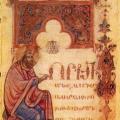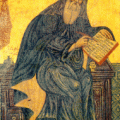303. Don’t Picture This: Iconoclasm
Is it idolatry to venerate an icon of a saint, or of Christ? The dispute leads the Byzantines to ponder the relation between an image and its object.
Themes:
• A. Louth (trans.), John of Damascus: Three Treatises on the Divine Images (Crestwood: 2003).
• C. Roth, St Theodor the Studite: On the Holy Icons (Crestwood NY: 1981).
• D. Sahas, Icon and Logos: Sources in Eighth-Century Iconoclasm (Toronto: 1986).
---
• T. Anagnostopoulos, “Aristotle and Byzantine Iconoclasm,” Greek, Roman, and Byzantine Studies 53 (2013), 763-90.
• C. Barber, Figure and Likeness: on the Limits of Representation in Byzantine Iconoclasm (Princeton: 2002).
• L. Brubaker, Inventing Byzantine Iconoclasm (Bristol: 2012).
• L. Brubaker and J.F. Haldon, Byzantium in the Iconoclast Era c. 680-850: a History (Cambridge: 2011).
• A. Bryer and J. Herrin (eds), Iconoclasm: Papers Given at the Ninth Spring Symposium of Byzantine Studies (Birmingham: 1977).
• K. Parry, Depicting the Word: Byzantine Iconophile Thought of the Eighth and Ninth Centuries (Leiden: 1996).
• T.T. Tollefson, St Theodore the Studite’s Defence of the Icons: Theology and Philosophy in Ninth-Century Byzantium (Oxford: 2018).






Comments
It's an intriguing episode.
It's an intriguing episode.
Peter, perhaps when you are at Wittgenstein with his picture theory of language, you should make reference to iconophiles. Or iconoclasts?
In reply to It's an intriguing episode. by Hristo
Wittgenstein
Or sooner than that I can refer back to it when I get to Protestant iconoclasm!
Iconoclasts and the cross
I was wondering if we have any sources that can help illuminate something for me I thought of during the episode.
I might be missing a key aesthetic distinction here, but iconoclasts seem to be able to dismiss the symbolism of the cross pretty handily here, and it really doesn't seem that easy to me. Certainly, inside a church, the cross is not a mere symbol - it IS the stand in for Christ - his entire essence in one symbol. You can take Christ off the cross, but he's really still there, otherwise what is the point of it being there at all?
Beyond that, at what point could iconoclasts be sure that when holding up the cross, praying in front of it, using it during ceremonies, etc. that one is still focused on Christ himself and not just lazily performing to the cross? And if church leaders couldn't be sure wouldn't it be better for the congregation to not have it?
It seems like drawing distinction from "face and body of holy people is bad" and "the easily recognizable thing that God himself died upon" is a thin line and I was wondering if either iconophiles pursued that argument somewhere or if iconoclasts confronted it more head-on.
In reply to Iconoclasts and the cross by Colin
The cross
That is a great question, and I vaguely recall wondering the same thing when I was reading up on this. I believe that basically, the iconoclasts saw a simple cross as clearly symbolic and therefore not likely to tempt people into worshiping created things - I mean, you wouldn't worship the cross itself anyway, right, because even the real cross was not a saint or Christ or in itself holy, it is just what Christ was crucified on, so a symbol of his sacrifice. (Though, people did collect supposed relics of the cross, so...) Of course the iconophiles had no reason to polemicize against the use of crosses, since they used them to. What I can't remember is whether the iconophiles said that by using crosses the iconoclasts were being hypocritical; probably they did since it is an obvious move, but maybe someone else more steeped in the material can tell us for sure.
Add new comment